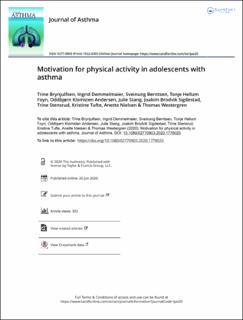| dc.contributor.author | Brynjulfsen, Trine | |
| dc.contributor.author | Demmelmaier, Ingrid | |
| dc.contributor.author | Berntsen, Sveinung | |
| dc.contributor.author | Foyn, Tonje Hellum | |
| dc.contributor.author | Andersen, Oddbjørn Klomsten | |
| dc.contributor.author | Stang, Julie | |
| dc.contributor.author | Sigdestad, Joakim Brodvik | |
| dc.contributor.author | Stensrud, Trine | |
| dc.contributor.author | Tufte, Kristine R. | |
| dc.contributor.author | Nielsen, Anette | |
| dc.contributor.author | Westergren, Thomas | |
| dc.date.accessioned | 2021-02-01T09:39:17Z | |
| dc.date.available | 2021-02-01T09:39:17Z | |
| dc.date.created | 2020-08-18T13:07:00Z | |
| dc.date.issued | 2020 | |
| dc.identifier.citation | Journal of Asthma. 2020, under utgivelse. | en_US |
| dc.identifier.issn | 0277-0903 | |
| dc.identifier.uri | https://hdl.handle.net/11250/2725499 | |
| dc.description | This is an Open Access article distributed under the terms of the Creative Commons Attribution-NonCommercial-NoDerivatives License (http://creativecommons.org/licenses/by-nc-nd/4.0/), which permits non-commercial re-use, distribution, and reproduction in any medium, provided the original work is properly cited, and is not altered, transformed, or built upon in any way. | en_US |
| dc.description.abstract | Objective: We explored motivation for physical activity (PA) and exercise in adolescents with asthma who entered and continued a 10-week play-based exercise intervention. Methods: Eighteen adolescents with asthma, aged 13–17 years, participated in a 10-week play- and interval-based indoor exercise intervention during winter and autumn months. Semi-structured focus group interviews were conducted in weeks 2 and 8, focusing on motivation for PA and exercise, as well as field observations of exercise sessions in weeks 2, 6, and 8. The first interview was analyzed separately from the second one and descriptive observational data were obtained using thematic analysis and self-determination theory as a framework. Results: In the first round of focus group interviews, participants (n = 18) described amotivation and motivation for PA within the following five themes: “teachers’ lack of asthma knowledge”, “embarrassment over asthma symptoms”, “not being able to keep pace with peers”, “seasonal challenges”, and “mastering fun physical activities”. Based on the second interview (n = 14) and descriptive observational data (n = 18), participants reported and revealed amotivation and motivation for PA within the following four themes: “understanding and relatedness”, “social support”, “competition”, and “mastering fun activities”. Conclusion: We conclude that play-based exercises designed for groups of adolescents with asthma can support motivation for PA and exercise and reduce social and asthma-specific barriers. | en_US |
| dc.language.iso | eng | en_US |
| dc.subject | exercise | en_US |
| dc.subject | obstructive lung disease | en_US |
| dc.subject | focus groups | en_US |
| dc.subject | qualitative research | en_US |
| dc.subject | youth | en_US |
| dc.subject | play | en_US |
| dc.subject | barriers | en_US |
| dc.title | Motivation for physical activity in adolescents with asthma | en_US |
| dc.type | Peer reviewed | en_US |
| dc.type | Journal article | en_US |
| dc.description.version | publishedVersion | en_US |
| dc.rights.holder | © 2020 The Author(s) | en_US |
| dc.source.pagenumber | 9 | en_US |
| dc.source.journal | Journal of Asthma | en_US |
| dc.identifier.doi | 10.1080/02770903.2020.1778025 | |
| dc.identifier.cristin | 1823828 | |
| dc.description.localcode | Institutt for idrettsmedisinske fag / Department of Sports Medicine | en_US |
| cristin.ispublished | true | |
| cristin.fulltext | original | |
| cristin.qualitycode | 1 | |
